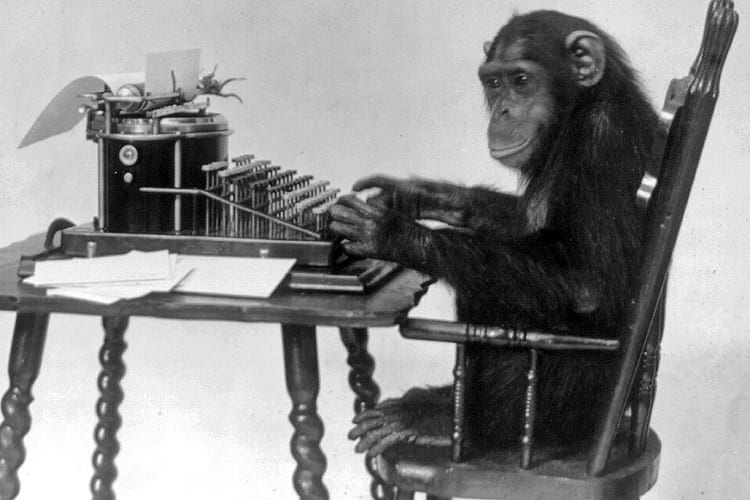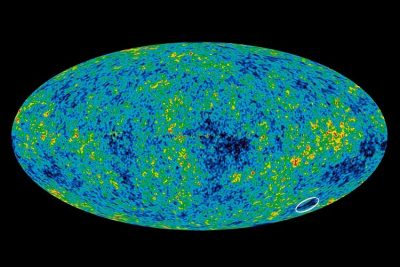The post Infinite Monkey Theorem: Can Monkeys Type Up the Entire Works of Shakespeare? appeared first on .
]]>
A chimpanzee sitting in front of a typewriter. (New York Zoological Society)
Imagine a group of monkeys typing away diligently on typewriters. They are typing random letters. If they continue typing random letters in this manner for an infinite amount of time, they may, at some point, end up typing Shakespeare’s complete works or any other literary texts or so the Infinite Monkey Theorem claims.
What is the Infinite Monkey Theorem?
The Infinite Monkey Theorem is an example of testing the limits of probability.
Probability is a mathematical measure for checking how often random phenomena take place. It calculates the likelihood of these events taking place. To get the probability of an event, we can use a quantifying number between zero and one. Here, if the number is zero, the event is unlikely to take place. If it is more than that, the probability of the event taking place will increase.
Generally, in probability, there may be several possible outcomes for an event. It is only by chance that we get the outcome we do.
When you consider a probability theory, you must deal with two types of events. The first event type does not adhere to the rules of the probability theory and is therefore entirely impossible in its context. The second event type follows the rules of the probability theory and is therefore possible. However, in this group, there are some events that occur frequently and some that occur so infrequently that they are almost unlikely to take place. However, even if rare, you cannot rule out their occurrence. They might not happen in a human lifespan, but they could possibly happen in a timespan of a billion and more years.
One well-known example of this is the Infinite Monkey Theorem. Given endless time and typewriters, the monkeys could potentially type up a storm of letter combinations. Here, we must assume that the monkeys will type every single letter of the alphabet and that there will be an even distribution of the typed letters. There would be a higher likelihood then that these letters could potentially form meaningful word sequences.
It might not happen in the first 1000 typed letters, but it could happen after a billion typed letters. And these word sequences could potentially form sentences. The sentences, in turn, could form paragraphs. And, in this way, we could, potentially, have the monkeys type out the entire works of Shakespeare.
The probability of that happening may be so minuscule as to be impossible, but we can’t rule it out.
Implications of the Infinite Monkey Theorem
Considered upfront, the Infinite Monkey Theorem might sound ridiculous, and, of course, nobody is going to be around for infinity to ever verify it. However, it does have some interesting philosophical implications that can alter our scientific outlook.
When we carry out scientific experiments or observations, we rely on the practical results to draw certain conclusions about the matter. But how reliable exactly are these results? Going by the Infinite Monkey Theorem, they are not 100 percent reliable. There are limits that the experiment results cannot overcome. For instance, even if you carry out hundreds of thousands of experiments and don’t get a certain result, it doesn’t mean that the result is completely out of the question. It could possibly occur, given an infinite amount of time. So, basically, you cannot confirm theories with a 100 percent certainty.
Another thing with the Infinite Monkey Theorem is that people often assume that if you have an infinite amount of time to resolve an issue, you will probably be able to do so. That is also not necessarily true. We need to reconsider the assumption that if something continues for infinity, it will eventually produce a result. Even if the event follows all the rules of the probability theory, it doesn’t automatically follow that there will be a tangible result.
Conducting the Infinite Monkey Theorem experiment
While the monkeys in the Infinite Monkey Theorem are just allegorical, Researchers at Plymouth University in England decided to carry out the experiment with actual monkeys. They placed a computer in an enclosure of six Sulawesi crested macaques in the Paignton Zoo in southwest England and waited to see what kind of literature the monkeys would produce. At the start, the monkeys weren’t interested in doing any writing. One male monkey tried to smash the computer with stones. The others defecated and urinated over it. Finally, they poked at the keyboard and were amazed when letters appeared on the screen. They found that so fascinating, it motivated them to get writing.
The monkeys, however, didn’t type random letters. They appeared to type some letters more often than the others, notably the letter S. They also showed a preference for the letters A, J, L, and M. Since there was no chance of the monkeys typing away for an infinite amount of time here, the experiment remained inconclusive. In the given amount of time, however, the monkeys did not write anything from Shakespeare or any other book.
Infinite Monkey Theorem computer experiment
Jesse Anderson, a US American programmer, tested the Infinite Monkey Theorem in 2011 with a software program he wrote to generate random characters. Whenever the characters formed a sentence sequence that matched a sentence from Shakespeare, the program marked it. In this way, it took nearly two months for the program to mark the entire works of Shakespeare.
In conclusion
The mathematician Emile Borel introduced the Infinite Monkey Theorem in his article Mécanique Statistique et Irréversibilité, published in the Journal of Physics in 1913. Later, the astronomer Arthur Eddington popularized it. The theory was mentioned in Russel Maloney’s science fiction short story Inflexible Logic and also in Douglas Adams’s Hitchhiker’s Guide to the Galaxy.
An interesting thing about the Infinite Monkey Theorem is that it restricts itself to an unspecified number of monkeys typing away for an infinite amount of time. According to the theory, this incessant typing alone is enough to create literary works. Which basically means that given enough time and brute force, it is possible to get almost anything done. There is no mention of the intelligence and creativity that, in real life, are necessary factors for creating literary works and other intellectual works of a high order.
Enjoyed this article? Also, check out “Graham’s Number: A Finite Number that Cannot Be Contemplated“.
Fact Analysis:
STSTW Media strives to deliver accurate information through careful research. However, things can go wrong. If you find the above article inaccurate or biased, please let us know at [email protected].
RELATED
The post Infinite Monkey Theorem: Can Monkeys Type Up the Entire Works of Shakespeare? appeared first on .
]]>The post Graham’s Number: A Finite Number That Cannot Be Contemplated appeared first on .
]]>Back to the topic, if each digit of Graham’s number occupied just one ‘Planck volume’, still, there would not be enough space in the observable universe to completely write it down. According to Brilliant.org, ‘Graham’s number is a tremendously large finite number that is a proven upper bound to the solution of a certain problem in Ramsey theory.’ It was discovered by Ronald Graham who was attempting to find a solution to the same problem. While Graham couldn’t find the solution, he proved that the solution to the problem was less than his number.
Graham’s Number is widely recognized as one of the biggest numbers which have been used in proving a mathematical concept. It made into the Guinness Book of World Record for the same in 1980. With all that being said, you might be wondering on how do we define this number, after all, it is a finite number. The Graham’s number is too big to be written in normal digit form. It is even too big to be written in the forms of exponents or power tower forms (for example 2 2 =4 ), something that most of us are quite familiar with. Fortunately, this seemingly huge number can be expressed with the help of what, in mathematics, is known as the Knuth’s Up-Arrow notation. Knuth’s Up-Arrow notation is just a fancy way of defining powers of the numbers, for example,

If we repeat this process and keep going till g 64 , we get Graham’s Number or G. Graham’s number is huge and has a very, very large amount of digits. The human brain is not efficient or capable enough of storing such a large amount of information and could cause the formation of a black hole in the brain if tried to do so. We might never be able to find out the first digit of Graham’s number, but we know that its last digit is 7. In fact, Graham’s number has been calculated backwards, we know around 400 to 500 of its last digits. While no matter how seemingly big or mind-boggling this number seems to be, it is still a zero to infinity.
Enjoyed this article? Also, check out “Infinite Monkey Theorem: Can Monkeys Type Up the Entire Works of Shakespeare?“.
Recommended Read:
The Colossal Book of Mathematics – Classic Puzzles, Paradoxes & Problems | By Martin Gardner
Fact Analysis:
STSTW Media strives to deliver accurate information through careful research. However, things can go wrong. If you find the above article inaccurate or biased, please let us know at [email protected].
RELATED
The post Graham’s Number: A Finite Number That Cannot Be Contemplated appeared first on .
]]>






